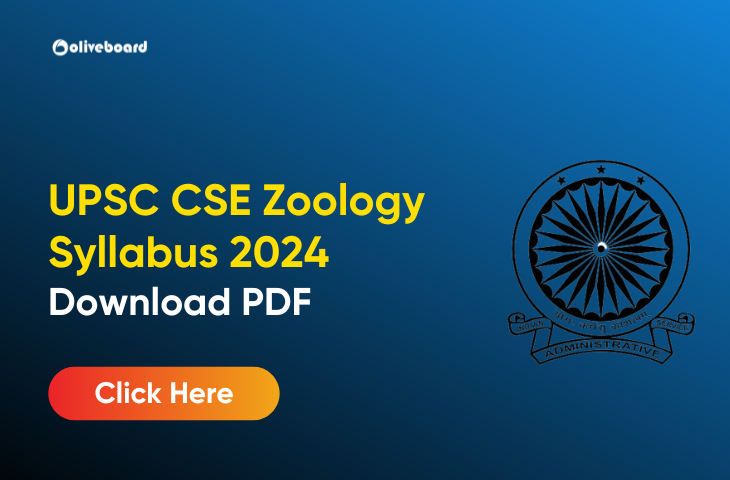UPSC Zoology Syllabus 2024
The UPSC Zoology Syllabus 2024 encompasses broad areas like animal diversity, genetics, evolution, anatomy, physiology, ecology, ethology, cell biology, and more. The wide-ranging UPSC Zoology Syllabus 2024 tests the fundamentals and advanced concepts in the field. UPSC evaluates both theoretical knowledge and practical applications through this optional subject.
You can download the UPSC CSE Zoology Optional paper Syllabus from the direct link given below.
UPSC Zoology Syllabus 2024 Overview
There is a list of optional subjects for mains in which there are 48 subjects, from which candidates can choose according to their choice. Zoology is one of the optional subjects for the Civil Services Exam conducted by UPSC. The optional paper is conducted for 250 marks. The UPSC CSE optional subject Zoology Syllabus 2024 has two papers, Paper 1 and Paper 2.
Optional Zoology Syllabus for UPSC CSE 2024
The UPSC Zoology syllabus covers highly specialized topics like classification, ecology, cytology, genetics, theoretical and applied zoology. The optional subject has two papers in UPSC Mains. The comprehensive syllabus tests fundamentals and advanced concepts to equip aspirants with scientific aptitude for biodiversity conservation and policymaking.
If you opt for Zoology optional in UPSC mains, prepare it thoroughly. Go through the UPSC CSE Syllabus and previous years’ Zoology papers. Also study relevant Zoology books for UPSC preparation.
UPSC CSE Zoology Syllabus 2024 for Paper 1
1. Non-chordata and Chordata:
- Classification and Relationship of Various Phyla: Acoelomate and Coelomate, Protostomes and Deuterostomes, Bilateria and Radiata.
- Status of Protista, Parazoa, Onychophora, and Hemichordata: Symmetry.
- Protozoa: Locomotion, Nutrition, Reproduction, Sex; General Features and Life History of Paramaecium, Monocystis, Plasmodium, and Leishmania.
- Porifera: Skeleton, Canal System, and Reproduction.
- Cnidaria: Polymorphism, Defensive Structures and Their Mechanism; Coral Reefs and Their Formation; Metagenesis; General Features and Life History of Obelia and Aurelia.
- Platyhelminthes: Parasitic Adaptation; General Features and Life History of Fasciola and Taenia and Their Pathogenic Symptoms.
- Nemathelminthes: General Features, Life History, Parasitic Adaptation of Ascaris and Wuchereria.
- Annelida: Coelom and Metamerism; Modes of Life in Polychaetes; General Features and Life History of Nereis, Earthworm, and Leech.
- Arthropoda: Larval Forms and Parasitism in Crustacea; Vision and Respiration in Arthropods (Prawn, Cockroach, and Scorpion); Modification of Mouth Parts in Insects (Cockroach, Mosquito, Housefly, Honey Bee, and Butterfly); Metamorphosis in Insects and Its Hormonal Regulation; Social Behaviour of Apis and Termites.
- Molluscs: Feeding, Respiration, Locomotion; General Features and Life History of Lamellidens, Pila, and Sepia; Torsion and Detorsion in Gastropods.
- Echinodermata: Feeding, Respiration, Locomotion, Larval Forms; General Features and Life History of Asterias.
- Protochordata: Origin of Chordates; General Features and Life History of Branchiostoma and Herdmania.
- Pisces: Respiration, Locomotion, Migration.
- Amphibia: Origin of Tetrapods, Parental Care, Paedomorphosis.
- Reptilia: Origin of Reptiles, Skull Types, Status of Sphenodon and Crocodiles.
- Aves: Origin of Birds, Flight Adaptation, Migration.
- Mammalia: Origin of Mammals, Dentition; General Features of Egg-laying Mammals, Pouched Mammals, Aquatic Mammals, and Primates; Endocrine Glands and Their Interrelationships.
- Comparative Functional Anatomy of Various Systems of Vertebrates: Integument and Its Derivatives, Endoskeleton, Locomotory Organs, Digestive System, Respiratory System, Circulatory System Including Heart and Aortic Arches, Urinogenital System, Brain and Sense Organs (Eye and Ear).
2. Ecology:
- Biosphere: Concept of Biosphere; Biomes, Biogeochemical Cycles; Human-induced Changes in Atmosphere Including Greenhouse Effect; Ecological Succession; Biomes and Ecotones; Community Ecology.
- Concept of Ecosystem: Structure and Function of Ecosystem; Types of Ecosystem; Ecological Adaptation.
- Population: Characteristics, Population Dynamics, Population Stabilization.
- Biodiversity and Diversity Conservation of Natural Resources.
- Wildlife of India.
- Remote Sensing for Sustainable Development.
- Environmental Biodegradation: Pollution and Its Impact on Biosphere and Its Prevention.
3. Ethology:
- Behaviour: Sensory Filtering, Responsiveness, Sign Stimuli, Learning, and Memory; Instinct, Habituation, Conditioning, Imprinting.
- Role of Hormones in Drive; Role of Pheromones in Alarm Spreading; Crypsis, Predator Detection, Predator Tactics; Social Hierarchies in Primates, Social Organization in Insects.
- Orientation, Navigation, Homing; Biological Rhythms: Biological Clock, Tidal, Seasonal, and Circadian Rhythms.
- Methods of Studying Animal Behaviour Including Sexual Conflict, Selfishness, Kinship, and Altruism.
4. Economic Zoology:
- Apiculture, Sericulture, Lac Culture, Carp Culture, Pearl Culture, Prawn Culture, Vermiculture.
- Major Infectious and Communicable Diseases: Their Vectors, Pathogens, and Prevention.
- Cattle and Livestock Diseases: Their Pathogen (Helminths) and Vectors (Ticks, Mites, Tabanus, Stomoxys).
- Pests of Sugar Cane, Oilseed, and Rice.
- Transgenic Animals.
- Medical Biotechnology, Human Genetic Disease and Genetic Counselling, Gene Therapy.
- Forensic Biotechnology.
5. Biostatistics:
- Designing of Experiments; Null Hypothesis; Correlation, Regression, Distribution and Measure of Central Tendency; Chi-square, Student-test, F-test (One-way & Two-way F-test).
6. Instrumentation Methods:
- Spectrophotometer, Phase Contrast and Fluorescence Microscopy, Radioactive Tracer, Ultra Centrifuge, Gel Electrophoresis, PCR, ELISA, FISH, and Chromosome Painting.
- Electron Microscopy (TEM, SEM).
UPSC CSE Zoology Syllabus 2024 for Paper 2
1. Cell Biology:
- Structure and Function of Cell and Its Organelles: Nucleus, Plasma Membrane, Mitochondria, Golgi Bodies, Endoplasmic Reticulum, Ribosomes, and Lysosomes.
- Cell Division: Mitosis and Meiosis, Mitotic Spindle and Mitotic Apparatus, Chromosome Movement, Types of Chromosomes (Ploidy and Lampbrush), Organization of Chromatin, Heterochromatin, Cell Cycle Regulation.
- Nucleic Acid Topology: DNA Motif, DNA Replication, Transcription, RNA Processing, Translation, Protein Folding and Transport.
2. Genetics:
- Modern Concept of Gene: Split Gene, Genetic Regulation, Genetic Code.
- Sex Chromosomes and Their Evolution: Sex Determination in Drosophila and Man.
- Mendel’s Laws of Inheritance: Recombination, Linkage, Multiple Alleles, Genetics of Blood Groups, Pedigree Analysis, Hereditary Diseases in Man.
- Mutations and Mutagenesis.
- Recombinant DNA Technology: Plasmid, Cosmid, Artificial Chromosomes as Vectors, Transgenics, DNA Cloning and Whole Animal Cloning.
- Gene Regulation and Expression in Prokaryotes and Eukaryotes.
- Signal Molecules, Cell Death, Defects in Signaling Pathway and Consequences.
- RFLP, RAPD, and AFLP and Application of RFLP in DNA Fingerprinting, Ribozyme Technologies, Human Genome Project, Genomics, and Proteomics.
3. Evolution:
- Theories of Origin of Life.
- Theories of Evolution: Natural Selection, Role of Mutation in Evolution, Evolutionary Patterns, Molecular Drive, Mimicry, Variation, Isolation, and Speciation.
- Evolution of Horse, Elephant, and Man Using Fossil Data.
- Hardy-Weinberg Law.
- Continental Drift and Distribution of Animals.
4. Systematics:
- Zoological Nomenclature, International Code, Cladistics, Molecular Taxonomy, and Biodiversity.
5. Biochemistry:
- Structure and Role of Carbohydrates, Fats, Fatty Acids, Cholesterol, Proteins, Amino Acids, and Nucleic Acids. Bioenergetics.
- Glycolysis and Krebs Cycle, Oxidation and Reduction, Oxidative Phosphorylation, Energy Conservation and Release, ATP, Cyclic AMP.
- Hormone Classification, Biosynthesis, and Functions.
- Enzymes: Types and Mechanisms of Action.
- Vitamins and Co-enzymes.
- Immunoglobulin and Immunity.
6. Physiology (with Special Reference to Mammals):
- Composition and Constituents of Blood: Blood Groups, Rh Factor, Factors and Mechanism of Coagulation, Iron Metabolism, Acid-Base Balance, Thermoregulation, Anticoagulants.
- Haemoglobin: Composition, Types, and Role in Transport of Oxygen and Carbon Dioxide.
- Digestion and Absorption: Role of Salivary Glands, Liver, Pancreas, and Intestinal Glands.
- Excretion: Nephron and Regulation of Urine Formation, Osmoregulation, Excretory Products.
- Muscles: Types, Mechanism of Contraction of Skeletal Muscles, Effects of Exercise on Muscles.
- Neuron: Nerve Impulse Conduction, Synaptic Transmission, Neurotransmitters.
- Vision, Hearing, and Olfaction in Man.
- Physiology of Reproduction: Puberty, Menopause in Humans.
7. Developmental Biology:
- Gametogenesis: Spermatogenesis, Oogenesis, Capacitation of Mammalian Sperm, Totipotency, Fertilization, Morphogenesis, Morphogen, Blastogenesis, Establishment of Body Axes, Gestulation in Frog and Chick.
- Cell Lineage, Cell-to-Cell Interaction, Genetic and Induced Teratogenesis, Thyroxine Control of Metamorphosis in Amphibia, Paedogenesis, Neoteny, Cell Death, Aging.
- Developmental Genes in Man, In Vitro Fertilization, Cloning.
- Stem Cells: Sources, Types, and Their Use in Human Welfare.
- Biogenetic Law.
Mastering the syllabus requires grasping complex biological and zoological processes. Preparing across diverse animal taxa develops scientific aptitude and analytical skills relevant for governance roles. Understanding animal interactions with the environment also has crucial policy implications. The dynamic UPSC Zoology Syllabus 2024 equips aspirants to address biodiversity conservation and other challenges.
| Important Links | Important Links |
| UPSC CSE 2024 Apply Online | UPSC CSE 2024 Notification |
| UPSC CSE Eligibility Criteria | UPSC CSE Syllabus |
| UPSC CSE Exam Pattern | UPSC CSE Selection Process |
UPSC Zoology Syllabus 2024 FAQs
The UPSC Zoology Syllabus 2024 encompasses broad areas like animal diversity, genetics, evolution, anatomy, physiology, ecology, ethology, cell biology, and more. The wide-ranging UPSC Zoology Syllabus 2024 tests the fundamentals and advanced concepts in the field. UPSC evaluates both theoretical knowledge and practical applications through this optional subject.
Get Syllabus PDF here: UPSC CSE Zoology Syllabus
There is 250 marks is for one optional paper.

Hello, I’m Aditi the creative mind behind the words at Oliveboard. As a content writer specializing in state-level exams, my mission is to simplify complex exam information and help aspirants navigate their journey with clarity and confidence.
Having walked the path of an aspirant myself, I bring a unique, relatable perspective to my work. I focus on crafting accessible and accurate content on Exam Notifications, Admit Cards, and Results, ensuring candidates have the right information at the right time.
At Oliveboard, I play a key role in empowering students by breaking down the exam process into understandable and actionable insights. My aim is to make preparation less daunting and more rewarding, one well-informed step at a time.
